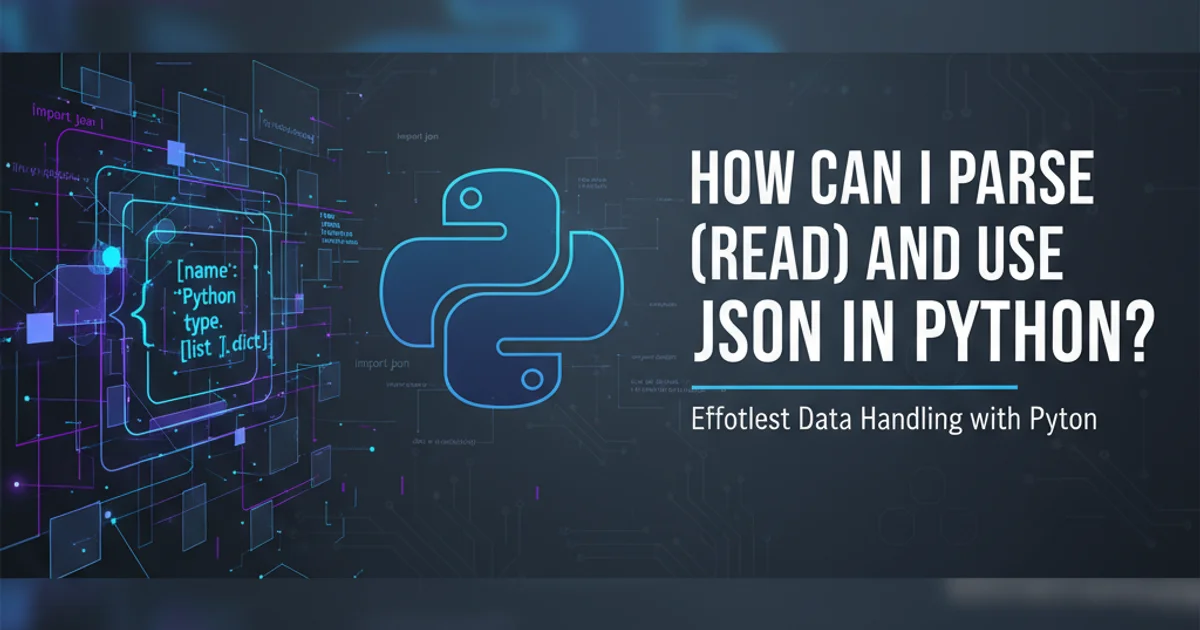How can I parse (read) and use JSON in Python?
Categories:
Parsing and Using JSON Data in Python

Learn how to effectively parse, manipulate, and work with JSON (JavaScript Object Notation) data in Python using the built-in json module.
JSON (JavaScript Object Notation) has become the de facto standard for data interchange on the web. Its human-readable format and lightweight nature make it ideal for APIs, configuration files, and data storage. Python provides excellent built-in support for working with JSON through its json module, allowing you to easily convert JSON strings into Python objects and vice-versa.
Understanding JSON Structure
Before diving into parsing, it's crucial to understand the basic structure of JSON. JSON data is built on two primary structures:
- Objects: A collection of name/value pairs. In Python, this maps directly to a dictionary.
- Arrays: An ordered list of values. In Python, this maps directly to a list.
Values can be strings, numbers, booleans, null, or nested objects/arrays. This hierarchical structure allows for complex data representation.
graph TD
A[JSON Data] --> B{Is it an Object?}
B -->|Yes| C[Python Dictionary]
B -->|No| D{Is it an Array?}
D -->|Yes| E[Python List]
D -->|No| F[Primitive Type (string, number, boolean, null)]
C --> G[Access with keys]
E --> H[Access with indices]
F --> I[Directly usable]Mapping JSON Structures to Python Data Types
Parsing JSON from a String
The most common scenario is receiving JSON data as a string, perhaps from a web API response or a file. Python's json.loads() method (short for 'load string') is used to parse a JSON formatted string and convert it into a Python dictionary or list.
import json
# JSON data as a string
json_string = '{"name": "Alice", "age": 30, "isStudent": false, "courses": ["Math", "Science"]}'
# Parse the JSON string into a Python dictionary
data = json.loads(json_string)
print(type(data))
print(data['name'])
print(data['courses'][0])
Parsing a JSON string into a Python dictionary
json.JSONDecodeError exceptions when parsing JSON from external sources, as malformed JSON can cause your program to crash.Parsing JSON from a File
When JSON data is stored in a file, you can read it directly using json.load() (without the 's'). This method takes a file-like object as an argument and parses the JSON content from it.
import json
# Assume 'data.json' contains: {"city": "New York", "population": 8400000}
# Create a dummy JSON file for demonstration
with open('data.json', 'w') as f:
json.dump({"city": "New York", "population": 8400000}, f)
# Open and load JSON from the file
with open('data.json', 'r') as file:
file_data = json.load(file)
print(type(file_data))
print(file_data['city'])
print(file_data['population'])
Loading JSON data directly from a file
Working with Parsed JSON Data
Once JSON data is parsed into Python dictionaries and lists, you can interact with it just like any other Python data structure. This includes accessing elements, iterating over collections, and modifying values.
import json
json_string = '{"user": {"id": 101, "name": "Bob", "email": "bob@example.com", "roles": ["admin", "editor"]}}'
data = json.loads(json_string)
# Accessing nested data
user_id = data['user']['id']
user_name = data['user']['name']
first_role = data['user']['roles'][0]
print(f"User ID: {user_id}")
print(f"User Name: {user_name}")
print(f"First Role: {first_role}")
# Modifying data
data['user']['email'] = 'new_bob@example.com'
data['user']['roles'].append('viewer')
# Adding new data
data['user']['status'] = 'active'
print(json.dumps(data, indent=2))
Accessing and modifying parsed JSON data
json.dumps() function (dump string) is the inverse of json.loads(). It converts a Python dictionary or list back into a JSON formatted string. The indent parameter makes the output human-readable.Handling Missing Keys Safely
When dealing with JSON from external sources, it's common for certain keys to be optional or missing. Directly accessing a missing key in a dictionary will raise a KeyError. You can prevent this using the .get() method or by checking for key existence.
import json
json_data = '{"product": {"id": "P123", "name": "Laptop"}}'
product_info = json.loads(json_data)
# Using .get() method
price = product_info['product'].get('price', 'N/A') # 'price' key is missing
category = product_info['product'].get('category') # Returns None if not found
print(f"Product Price: {price}")
print(f"Product Category: {category}")
# Checking for key existence
if 'description' in product_info['product']:
description = product_info['product']['description']
else:
description = 'No description available'
print(f"Product Description: {description}")
Safely accessing potentially missing keys in JSON data